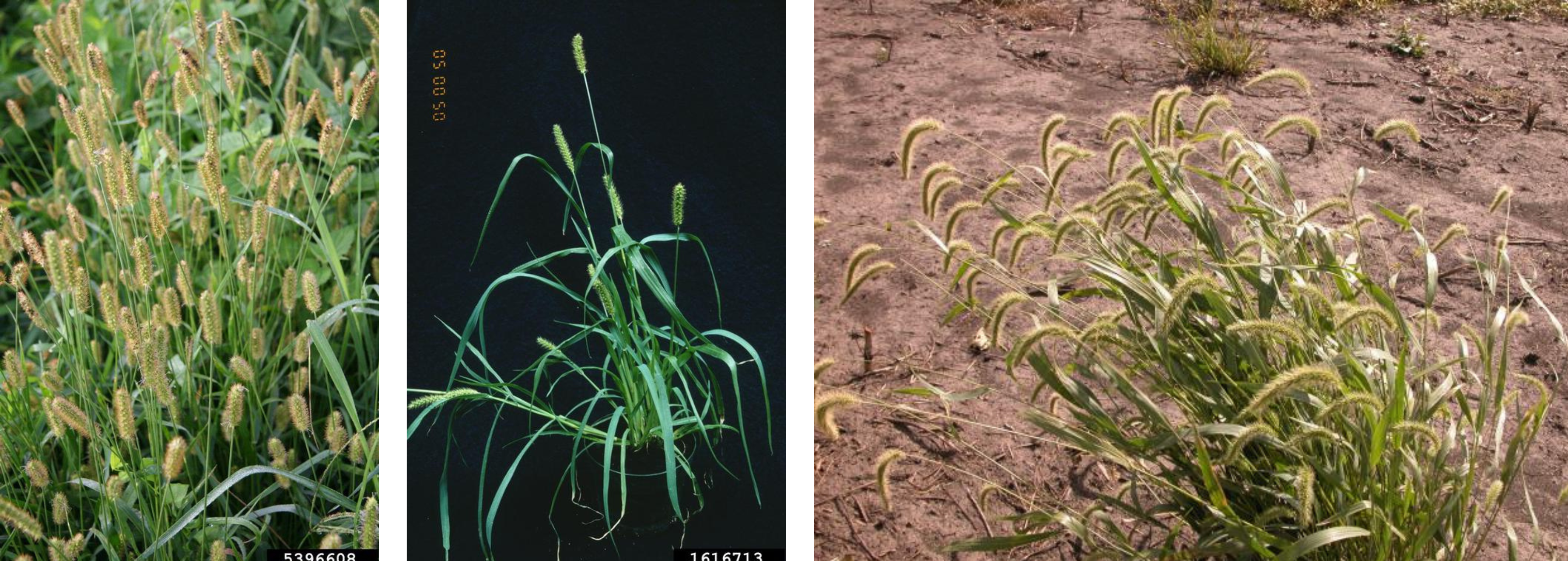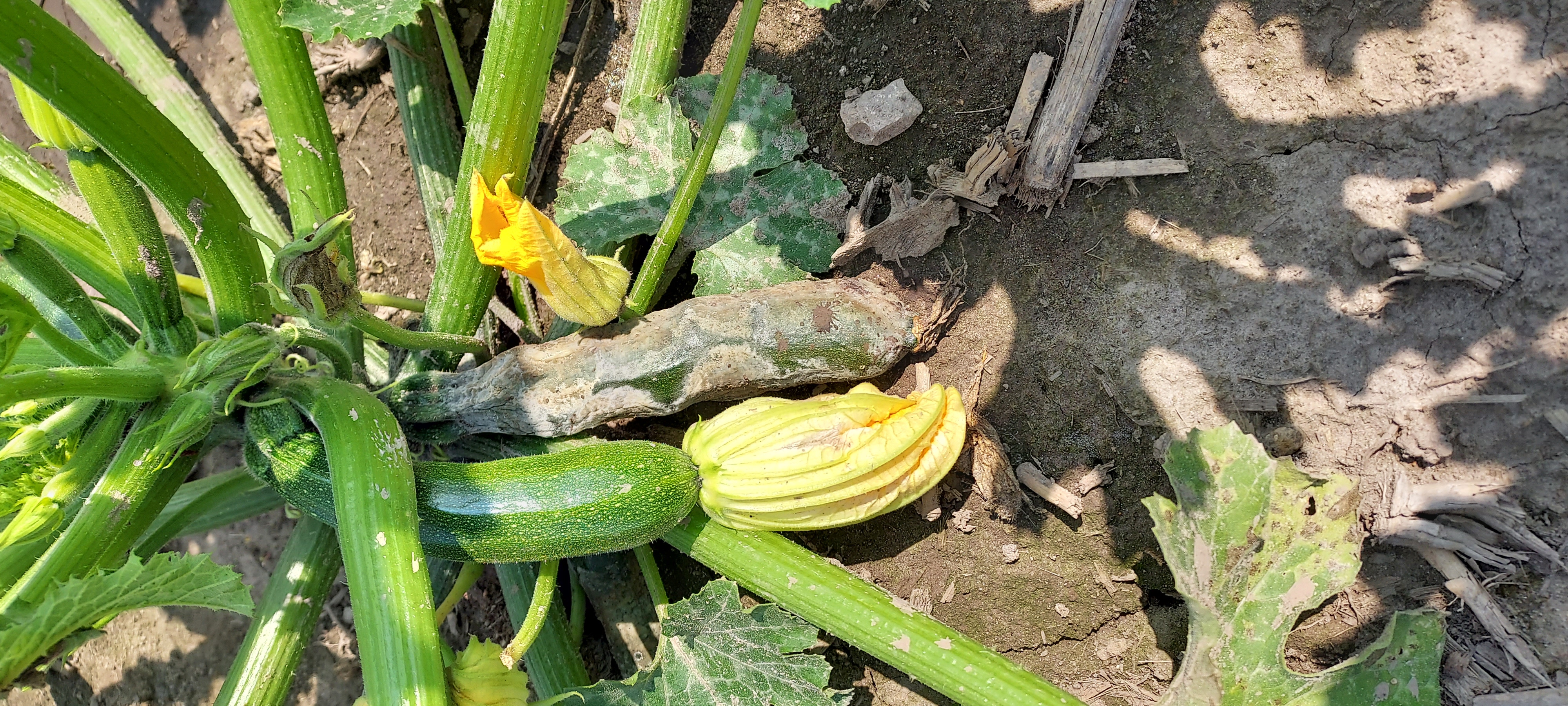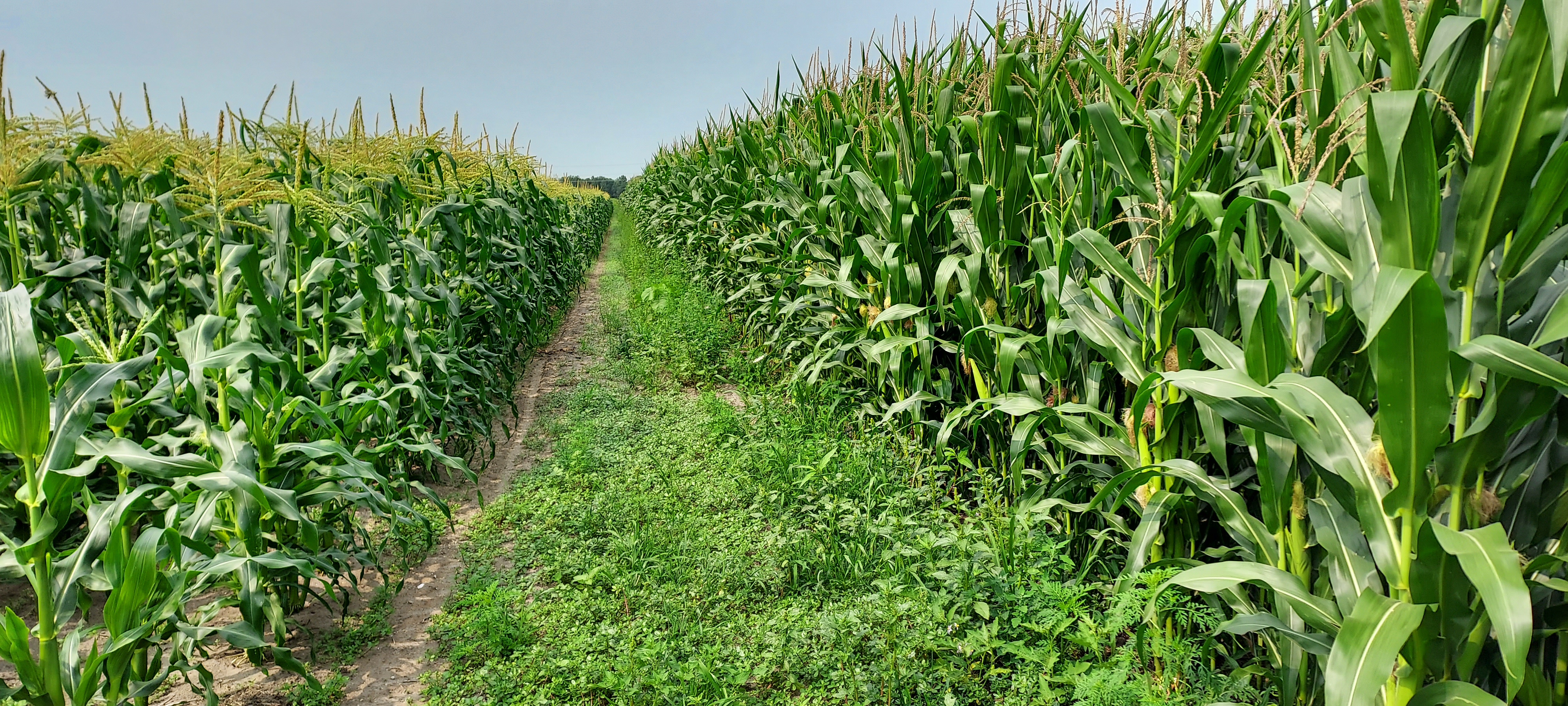Michigan vegetable crop report – August 2, 2023
Growers are controlling late-season pests and ensuring successful harvests.
Weather
Watch Dr. Andresen’s weather update here.
The past week saw cooler temperatures 2-3 degrees Fahrenheit above-normal with a cooler upper peninsula, with most areas receiving a good dose of rain with pockets of heavy rain in southwest and west central Michigan. Total rainfall for July was 200-300% of normal. It has been a record-setting type of weather whiplash, with some areas changing from a major seasonal rainfall deficit to a surplus.
The forecast calls for:
- Partly to mostly sunny, dry, and warm with scattered showers and thunderstorms possible north on Wednesday.
- Partly sunny with scattered showers and thunderstorms north on Thursday. Fair and warm with isolated showers possible south.
- Fair, dry, and cooler Friday and Saturday.
- Increasing clouds with showers and thunderstorms possible Sunday through Tuesday.
- High temperatures from the low 80s F north to upper 80s F south Wednesday and upper 70s F north to mid and upper 80s F Thursday, falling back to the upper 70s F to low 80s F Friday through this weekend. Low temperatures generally in the low-mid 60s F Thursday falling back to the mid-upper 50s F this weekend.
- Medium range outlooks generally call for near to below normal mean temperatures and near to above normal precipitation totals.
Weed of the Week
Foxtail weeds (Giant, green, and yellow foxtail) are summer annual grasses found throughout Michigan. Distinguishing between the three main foxtail species is generally based on 1) leaf hairs, and 2) seedhead appearance. Giant foxtail has short fine hairs on the upper leaf surface and forms a large drooping seedhead. Yellow foxtail has longer leaf hairs and forms a smaller, upright seedhead, with bristles (awns) that turn yellow at maturity. Green foxtail has hairless leaves and also forms an erect seedhead. With that said, identifying between the three is not generally necessary, as similar practices will control all foxtail weeds. A foxtail can be differentiated from other grasses at the seedling stage by the presence of a hairy ligule (collar-like structure growing from the leaf sheath that encloses the stem).
Many standard pre-emergents provide excellent control of foxtail grasses, including Curbit (ethalfluralin), Dual Magnum (s-metolachlor), Lorox (linuron), Prowl (pendimethalin), Treflan (trifluralin), and more. Many post-emergents also have good activity, including Shieldex (tolpyralate), Quinstar (quinclorac), and Tricor (metribuzin), as well as graminicides like Poast (sethoxydim), Select (clethodim), and Fusilade (fluazifop). Foxtail seeds have low persistence in the soil, so managing weed seed production can go a long way towards reducing foxtail pressure in future seasons.

2023 MSU Extension Southeast Michigan Farmer Survey
MSU Extension is pleased to announce our 2023 Southeast Michigan Farmer Needs Assessment Survey. This survey will gather information about your farm and your potential interest in learning more about various farm-related topics. The information gathered will inform future programs and educational opportunities offered by MSU Extension educators for agricultural producers in southeast Michigan. This survey will take approximately 10 minutes to complete and is accessible at the link below:
Take the 2023 MSU Extension Southeast Michigan Farmer Needs Assessment Survey!
Feel free to share the survey link with other growers. We welcome any participation in the survey in order to help Michigan State University Extension better serve its communities.
QuickBooks survey
QuickBooks is one of the most widely used financial software packages for farm financial records. It is a powerful tool but using it effectively for farm businesses can be confusing. MSU Extension is partnering with the University of Wisconsin and University of Nebraska to develop educational resources for using QuickBooks for farm records effectively and efficiently. It would be greatly appreciated if you would complete a short survey that will help us better understand what is desired for QuickBooks educational programming.
Crop updates
Asparagus
Disease severity value (DSV) accumulations were variable through July 28 across sites where MSU Extension and cooperators had sensors,, but at some dewy locations had accelerated with the humid weather. Azoxystrobin (e.g., Quadris, Sartori, A-Frame, AzoxyStar other generics) could be considered if/when there are a significant number of days with “3” and “2” daily DSVs (i.e., favorable purple spot weather). Otherwise, chlorothalonil or mancozeb can protect against purple spot and provide some help with rust. Any of these can be tank mixed with tebuconazole to add some rust protection.
Cole crops and leafy greens
Diamondback moth damage was visible in some areas this week. Note, this pest has a history of insecticide resistance, including to pyrethroids. This mode of action works well for imported cabbage worm, but in some areas may not work for diamondback moth. Diamides like chlorantraniliprole (Besiege, Coragen) can help provide control in these areas. For brassica transplants, tray drenches with Verimark-another diamide-can provide early worm control. The diamides should also be softer on beneficials that help keep aphids and diamondback moth in check.
Cucurbits/pickles
Harvest of processing zucchini had started in west central Michigan this week-with some early planted fresh-market winter squash coming soon. Harvest rolls on in other parts of the state.
Implementing an aggressive spray program for Phytophthora fruit rot? Don’t forget to “disk the mess and protect the rest.” Keep an eye out for plant death and fruit rot. When you see it starting, disk under the affected plants plus a firewall of healthy ones. It is analogous to a firebreak. You are removing fuel (infected host plants) for the fire to slow it down, to lessen the load on your firefighting crew of fungicides. Both tactics work together.
Spray coverage is also important; consider using at least 30 gpa of water and/or whatever helps improve fruit coverage.

Lastly, some growers have a mix of “virgin” ground and land with a history of the disease. If you are in this boat, do fieldwork in the infested field last, to avoid moving infested soil to newer sites. Then power wash equipment to remove soil.
Cucurbit downy mildew has been confirmed in 5 counties to date: Saginaw, Monroe, Washtenaw, Ingham and Branch. Downy mildew spores were being captured through July 26 in Monroe, Berrien, Bay, Saginaw and Ingham Counties. So far it is all clade-2, which infects cucumbers, pickles and melons. See this report for details on fungicides.
Fruiting vegetables
Field-grown tomato harvests began this week and now all the fruiting vegetables are going to market. Conditions have been favorable for development of foliar fungal and bacterial diseases, and Phytophthora has flared up in some fields.
Verticillium wilt is appearing in eggplant. Symptoms of this soil-borne disease can be variable, but generally consist of browning vascular tissue in the main stem, as well as yellowing, wilt, and necrosis initially occurring on only one side of the plant/individual leaves before progressing further. There are no surefire ways to control Verticillium once it is established, control measures are generally preventative like growing resistant varieties, crop rotation, and fumigation. Learn more about this pathogen in this article from Cornell and this factsheet from North Carolina State University Extension
Potatoes
Potato leafhopper damage is being observed, causing severe “hopperburn” and plant decline in some cases. Many insecticides used for Colorado potato beetle management will also be effective on leafhoppers. Likewise, certain natural enemies of Colorado potato beetle will feed on potato leafhoppers, such as lady beetles and lacewings.
Sweet corn
Sweet corn harvest is well underway now at some west central farms. Birds were wheeling above fields as various noisemakers pestered them. A nice factsheet on bird control tactics is here.
Corn earworm was present but had not reached high levels in MSU traps, nor in traps in Ohio. Captures were moderate in most Indiana traps, though two southern Indiana locations caught elevated numbers over the past week. On at least some farms, there has been a low incidence of worm damage so far. Insectforecast.com predicts a low risk of additional migration for the 5 days. Any non-zero catch may warrant treatment in silking sweet corn. A 5-day spray interval may suffice at captures of less than 5 per night in a steel trap (MSU Extension uses these). For the cloth traps, information on thresholds is here.
|
Corn earworm captures. Total in trap for week¹ (avg # per night²) |
|||||
|
Week |
Ottawa Co |
Oceana Co |
Monroe Co. |
Wayne Co. |
Berrien Co. |
|
7/31 |
0 |
0 |
0 |
0 |
1 (<1) |
|
7/24 |
2 (<1) |
1 (<1) |
0 |
1 (<1) |
1 (<1) |
|
7/17 |
0 (0) |
0 (0) |
0 (0) |
1 (<1) |
- |
|
7/10 |
- |
0 (0) |
0 (0) |
0 (0) |
- |
|
7/3 |
- |
0 (0) |
3 (<1) |
0 (0) |
- |
|
¹Total number collected since last trap check. ²The total number divided by the number of nights since the last trap check |
|||||
Note, field corn was silking in some areas; silking field corn is a magnet that can help alleviate pressure on sweet corn.

Western bean cutworm captures were higher this week in some MSU Extension traps, and also to our south in Ohio. You can scout for egg masses to determine if this pest is an issue, read this article to learn more. Sweet corn that is just at pre-tassel is most attractive to egg laying females.
|
Western bean cutworm captures. Total in trap for week¹ (avg # per night²) |
||||
|---|---|---|---|---|
|
Week |
Ottawa Co |
Oceana Co |
Monroe Co. |
Berrien Co. |
|
7/31 |
165 (24) |
15 (2) |
5 (<1) |
8 (1) |
|
7/24 |
112 (16) |
15 (2) |
- |
7 (1) |
|
7/17 |
- |
8 (1) |
- |
- |
|
7/10 |
- |
1 (<1) |
- |
- |
|
7/3 |
- |
0 (0) |
- |
- |
|
¹Total number collected since last trap check; ²The total number divided by the number of nights since the last trap check |
||||
What to spray? Corn earworms can be managed with pyrethroid, diamide or spinosyn insecticides. Pyrethroids include Ambush/Pounce, Asana, Baythroid, Capture/Brigade, Hero, Mustang Maxx, and Warrior. Diamides include chlorantraniliprole, which is in Besiege, Coragen and Vantacor. Spinosyns include spinetoram, or Radiant. In some places, pyrethroids have produced unsatisfactory results because of the development of resistance.
On-Farm Food Safety
MSU and the Conservation Districts offer a program to visit your farm to go over your food safety program to provide critiques and comfort in a confidential fashion. You can then use these notes to make changes ahead of an actual inspection from MDARD. If you are interested in an On-Farm Readiness Review, please fill out this OFRR request survey to start the scheduling process (the sooner the better).
Events
- August 3, 7–8 a.m.,Field Crops Virtual Breakfast: Identifying and Correcting Drainage Underperformance Issues
- August 3, 8 a.m. - 4 p.m., 2023 Montcalm County Field Day
- August 8, 9 a.m. - 12 p.m., MSU Extension Tillage Field Day
- August 8, 1-7 p.m., Specialty crop air and ground drone sprayer demos
- August 10, 7–8 a.m., Field Crops Virtual Breakfast: Drones for Spraying Pesticides - Opportunities & Challenges
- August 17, 7–8 a.m., Field Crops Virtual Breakfast: "Hot Topic" Q & A Session
- August 24, 7–8 a.m., Field Crops Virtual Breakfast: Timing The Last Irrigation Application
- August 31, 7–8 a.m., Field Crops Virtual Breakfast: Setting The Stage For Record Breaking Wheat Yields
- September 7, 7–8 a.m., Field Crops Virtual Breakfast: Marketing Your Grain Crops
- September 14, 7–8 a.m., Field Crops Virtual Breakfast: Monitoring Nematode Resistance In Soybeans
- September 19-21, Farm Science Review
- September 21, 7–8 a.m., Field Crops Virtual Breakfast: Fall Weed Control
- September 27, Wooster, OH, Midwest Mechanical Weed Control Field Day
This work is supported by the Crop Protection and Pest Management Program [grant no 2021-70006-35450] from the USDA National Institute of Food and Agriculture. Any opinions, findings, conclusions, or recommendations expressed in this publication are those of the author(s) and do not necessarily reflect the view of the U.S. Department of Agriculture.



 Print
Print Email
Email

